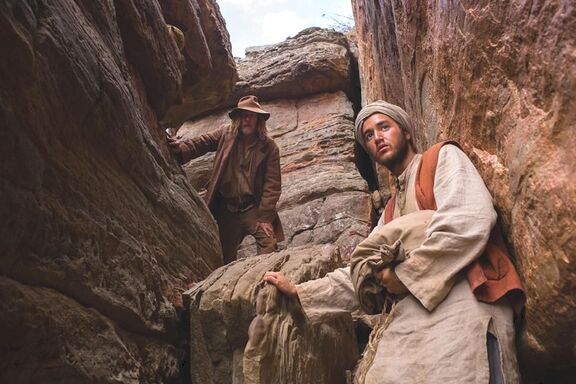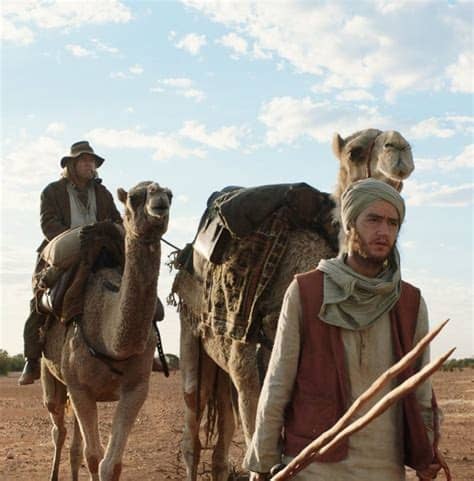THE FURNACE
****
Director: Roderick MacKay
Screenplay: Roderick MacKay
Principal cast:
Ahmed Malek
David Wenham
Jay Ryan
Erik Thomson
Trevor Jamieson
Baykali Ganambarr
Country: Australia
Classification: MA15+
Runtime: 116 mins.
Australian release date: 10 December 2020.
Australia has a violent history, largely thanks to the attitudes of the British when they colonised the country over two centuries ago. In Roderick MacKay’s first feature, The Furnace, which he also wrote, we see that brutal treatment was meted out not only to the Indigenous inhabitants of the continent but also to pretty much anyone of whom ‘the Crown’ disapproved, including many of the surprisingly multicultural new settlers. These people included Afghans, Indians, Persians and Chinese, among others, along with the English, Irish and Scots.
Set in the late 1890s in the vast expanse of Western Australia’s north during a gold rush, The Furnace takes us on a journey that is as harsh as the terrain where it was shot and is as bloody as any war film. We meet the ‘Ghan’ cameleers, who were predominately Moslems from Afghanistan and Persia (today’s Iran) and Sikhs and Hindus from India, brought here with their camels to create trade routes through the desert-like outback regions. Some of them established intimate relationships with the Indigenous tribes and, to this day, there are Aboriginals bearing names that refer back to those varied ethnic groups.
After a vicious encounter with a couple of white men, a young Afghan cameleer, Hanif (Ahmed Malek) teams up with a wounded renegade, Mal (David Wenham), who’s on the run with two stolen 400oz Crown-marked gold bars in his saddlebags. Hanif was originally travelling with a Sikh friend, Sadhu (Mahesh Jadu), and the two had become close to a local Aboriginal group led by Coobering (Trevor Jamieson); Hanif, in particular, had a friendly relationship with one of the tribe’s young hunters, Woorak (the charismatic Baykali Ganambarr, star of The Nightingale). Mal’s arrival marks the parting of the ways between the two mates because of their disparate attitude towards gold - Hanif hopes to return home with his share but Woorak sees no value in the “yellow rock.” Mal and the young Afghan need to get to the illegal furnace of the title, so they can melt the ingots down and make them unidentifiable. Heading cross-country, they are pursued by a small contingent of troopers headed by Sergeant Shaw (Jay Ryan), a cruel man with a ‘take no prisoners’ approach to policing. As they travel, Hanif and Mal develop a kind of grudging respect for each other as the power balance between them switches back and forth under the extreme circumstances of their perilous journey.
MacKay should be proud of his directorial debut and his multi-lingual screenplay, which features characters variously speaking English, Indigenous language, Pushto, Punjabi, Dari and Cantonese. The Egyptian actor Ahmed Malek plays Hanif as a fairly passive character when we first meet him but the scales fall from his eyes as he copes with the violence and it is fascinating to watch him mature and develop over the course of the action. Wenham is consistently good, this time playing an aggressive persona who softens over time. He sports a dirty wig of long, blonde hair which takes a bit of getting used to but, with his skill, you soon don’t notice it. There are some very violent scenes which reflect the harsh reality of the men’s situation. It is, after all, a fight for survival.
The Furnace is currently in release with little fanfare, which is a great pity, however, this informative film is a must-see for anyone interested in early Australian history; while this drama may be fictitious, the research which backs it up is accurate. It portrays a slice of history that has been largely forgotten. The Furnace shows how multicultural Australia has existed since the early days of ‘white’ settlement and it successfully exposes the commonly held view that it was only the British and the Chinese who first came to this continent. It also confirms the fact that minority nationalities have always had to fight to be accepted by the Australian authorities from the beginning of colonisation. And how little has changed since then.
Screenplay: Roderick MacKay
Principal cast:
Ahmed Malek
David Wenham
Jay Ryan
Erik Thomson
Trevor Jamieson
Baykali Ganambarr
Country: Australia
Classification: MA15+
Runtime: 116 mins.
Australian release date: 10 December 2020.
Australia has a violent history, largely thanks to the attitudes of the British when they colonised the country over two centuries ago. In Roderick MacKay’s first feature, The Furnace, which he also wrote, we see that brutal treatment was meted out not only to the Indigenous inhabitants of the continent but also to pretty much anyone of whom ‘the Crown’ disapproved, including many of the surprisingly multicultural new settlers. These people included Afghans, Indians, Persians and Chinese, among others, along with the English, Irish and Scots.
Set in the late 1890s in the vast expanse of Western Australia’s north during a gold rush, The Furnace takes us on a journey that is as harsh as the terrain where it was shot and is as bloody as any war film. We meet the ‘Ghan’ cameleers, who were predominately Moslems from Afghanistan and Persia (today’s Iran) and Sikhs and Hindus from India, brought here with their camels to create trade routes through the desert-like outback regions. Some of them established intimate relationships with the Indigenous tribes and, to this day, there are Aboriginals bearing names that refer back to those varied ethnic groups.
After a vicious encounter with a couple of white men, a young Afghan cameleer, Hanif (Ahmed Malek) teams up with a wounded renegade, Mal (David Wenham), who’s on the run with two stolen 400oz Crown-marked gold bars in his saddlebags. Hanif was originally travelling with a Sikh friend, Sadhu (Mahesh Jadu), and the two had become close to a local Aboriginal group led by Coobering (Trevor Jamieson); Hanif, in particular, had a friendly relationship with one of the tribe’s young hunters, Woorak (the charismatic Baykali Ganambarr, star of The Nightingale). Mal’s arrival marks the parting of the ways between the two mates because of their disparate attitude towards gold - Hanif hopes to return home with his share but Woorak sees no value in the “yellow rock.” Mal and the young Afghan need to get to the illegal furnace of the title, so they can melt the ingots down and make them unidentifiable. Heading cross-country, they are pursued by a small contingent of troopers headed by Sergeant Shaw (Jay Ryan), a cruel man with a ‘take no prisoners’ approach to policing. As they travel, Hanif and Mal develop a kind of grudging respect for each other as the power balance between them switches back and forth under the extreme circumstances of their perilous journey.
MacKay should be proud of his directorial debut and his multi-lingual screenplay, which features characters variously speaking English, Indigenous language, Pushto, Punjabi, Dari and Cantonese. The Egyptian actor Ahmed Malek plays Hanif as a fairly passive character when we first meet him but the scales fall from his eyes as he copes with the violence and it is fascinating to watch him mature and develop over the course of the action. Wenham is consistently good, this time playing an aggressive persona who softens over time. He sports a dirty wig of long, blonde hair which takes a bit of getting used to but, with his skill, you soon don’t notice it. There are some very violent scenes which reflect the harsh reality of the men’s situation. It is, after all, a fight for survival.
The Furnace is currently in release with little fanfare, which is a great pity, however, this informative film is a must-see for anyone interested in early Australian history; while this drama may be fictitious, the research which backs it up is accurate. It portrays a slice of history that has been largely forgotten. The Furnace shows how multicultural Australia has existed since the early days of ‘white’ settlement and it successfully exposes the commonly held view that it was only the British and the Chinese who first came to this continent. It also confirms the fact that minority nationalities have always had to fight to be accepted by the Australian authorities from the beginning of colonisation. And how little has changed since then.

